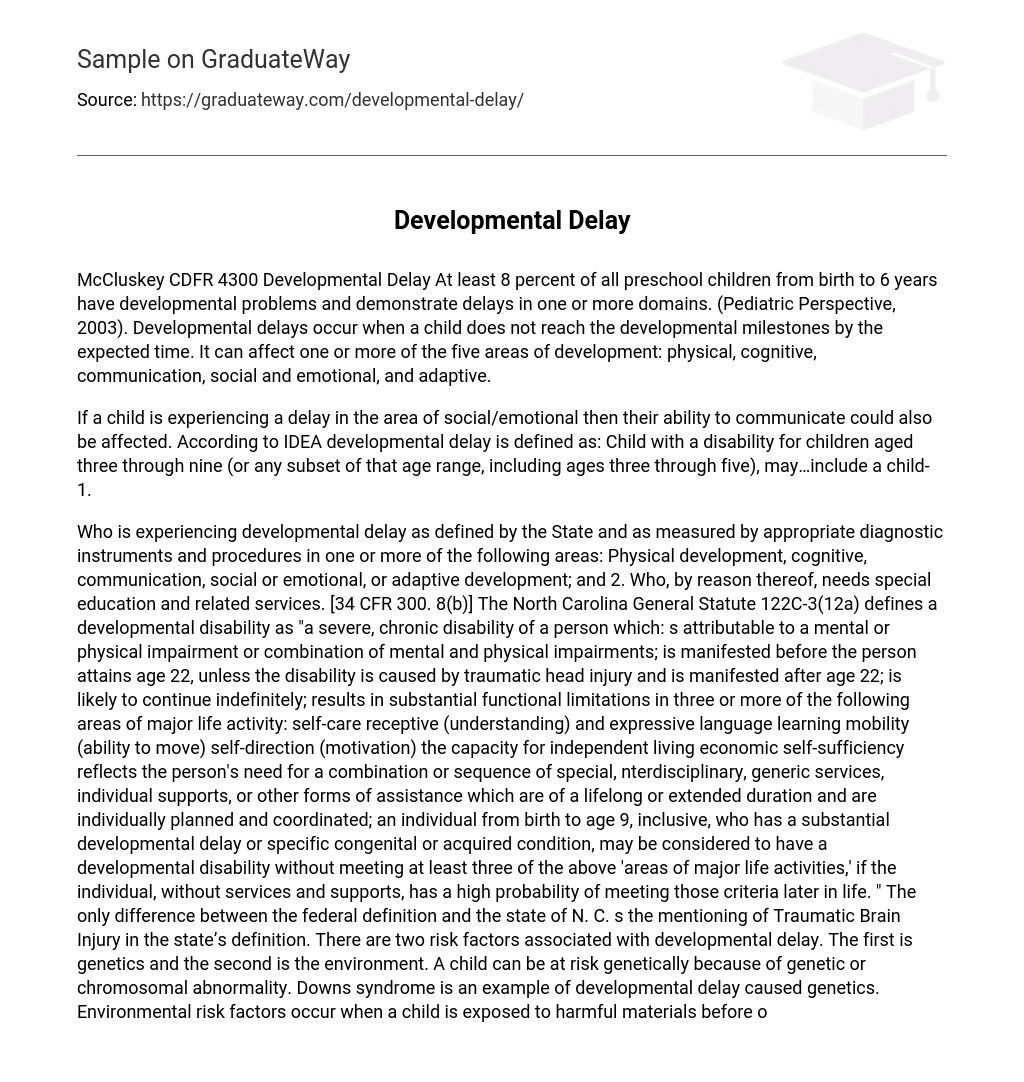According to a study conducted in 2003, approximately 8% of preschool children aged birth to 6 years old face developmental challenges and show delays in various areas. These delays become evident when a child is unable to reach expected developmental milestones within a specific time frame. This affects physical, cognitive, communication, social and emotional, as well as adaptive development.
Both the state of N.C. and the federal definition vary only in their mention of Traumatic Brain Injury within the state’s definition. Developmental delay has two factors that contribute to its occurrence: genetics and the environment. When it comes to genetic risk, a child may be affected by a genetic or chromosomal abnormality. For instance, Downs syndrome is an example of developmental delay caused by genetics. On the other hand, environmental risk factors arise when a child is exposed to harmful substances either before or after birth; this includes scenarios such as a mother using drugs during pregnancy, inadequate nutrition, or contracting a disease. Additionally, environmental risk factors also encompass the child’s life experiences.
Children who are more prone to developmental delay may be affected by a range of factors, including perinatal risk factors such as low birth weight, premature birth, viral infection, heart disease, and respiratory problems. Metabolic risk factors encompass significant feeding difficulties, persistent hypoglycemia, and other metabolic disorders. Lastly, neurological risk factors include intraventricular hemorrhage, intracranial pathology, and other neurological issues.
Various risk factors, such as lack of health care, poverty, low IQ, drug abuse, and maternal depression among parents, can cause developmental delays. Additionally, lack of support, violence, and social isolation in the community can also contribute to these delays. Furthermore, dysfunctional parenting, having multiple children in the family, and experiencing domestic violence within the family are additional risk factors (IAFP/FPEN, 2007).
Experts estimate that a significant number – around 70-80% – of children with developmental delays remain undiagnosed before they start school (IAFP/FPEN, 2007).
During well-baby checkups, the most effective method of identifying children who may be at risk for developmental delay is through open communication with parents regarding their concerns and by tracking developmental milestones. It is essential for parents to have knowledge about the specific developmental milestones that are expected at each stage of their child’s growth in order to anticipate and understand their progress.
The Social/Emotional developmental milestones for a typically developing child are listed below:
- 4 months- recognize most familiar adults;
- 6 mos. -reacts to strangers 9 mos. -plays peek-a-boo, and engages in exchanges of gestures, sounds, and facial expressions;
- 12 mos. -imitates gestures such as hugging a doll;
- 15 mos. -plays with other children;
- 18 mos. -engages in pretend play;
- 24 mos. – imitates behavior of others, especially adults and older children, increasingly aware of herself as separate from others, increasingly enthusiastic about company of other children;
- 36-48 mos. interested in new experiences, Cooperates with other children, Plays “Mom” or “Dad”, increasingly inventive in fantasy play, Dresses and undresses, Negotiates solutions to conflicts, more independent;
- 48-60 mos. – wants to please friends, wants to be like her friends, more likely to agree to rules, likes to sing, dance, and act; shows more independence and may even visit a next-door neighbor by herself, aware of sexuality, able to distinguish fantasy from reality, sometimes demanding, sometimes eagerly cooperative.
By familiarizing themselves with the aforementioned developmental milestones, parents can gauge whether their child is meeting expected benchmarks or if they should have some concerns. First Signs, a non-profit organization, suggests that parents and providers should take note of the subsequent warning signs regarding a child’s development.
- No big smiles or other warm, joyful expression by 6 months or later
- No back and forth sharing of sounds, smiles, or other facial expressions by 9 months
- No babbling by 9 months
- No words by 16 months
- No two-word meaningful phrases (without imitating or repeating) by 24 months
- Any loss of speech or babbling or social skills at any age
- Even with the use of above mentioned, there are still children who go undetected for developmental delays.
Child care providers should utilize their expertise and training to recognize children who may have developmental delays. It is important for them to employ available developmental screening tools, as well as other methods such as observation, documentation, identifying risk and protective factors in a child’s environment.
Developmental screenings and evaluations are play-based methods that aim to identify developmental delays. These assessments can be conducted through questionnaires or tests completed by parents, providers, healthcare professionals, or educational professionals. The screening is a broad and brief assessment that determines if further evaluation is necessary. Its purpose is to identify children facing difficulties and assess the extent of their delay.
The screening indicates that the child may have a developmental delay and needs further testing. Developmental evaluation is a thorough assessment conducted by an expert to gauge the child’s abilities. Evaluations help identify the child’s strengths and weaknesses in terms of development, determining if early intervention or treatment is required. Depending on the results of the developmental evaluation, early intervention and/or a treatment plan may be necessary.
Early intervention services encompass a range of resources and programs designed to enhance children’s development and support their families. These services, offered by both public and private agencies, consist of assistive technology, hearing services, educational programs, occupational and/or physical therapy, speech/language therapy, respite services, among others (FPEN/IAFP, 2007, January).
Reference
- Social and Emotional Development: Screening Strategies for Primary Care Providers http://www. iafp. rg/pdfs/SocialEmotional.
- A Pediatric Perspective. (1998, July/August). Developmental delay vs. developmental disorder in young children: Understanding the difference. Retrieved from http://www. gillettechildrens. org
- A Pediatric Perspective. (2003, July). Identifying Patterns of Developmental Delays Can Help Diagnose Neurodevelopmental Disorders. Retrieved from http://www. gillettechildrens. org Developmental
- Fact Sheet. (2009, August) Retrieved from http://www. nichcy. org





